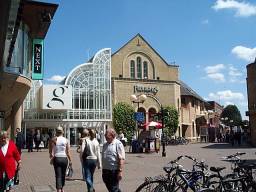
Market
Cambridge has never been a heavy industry city. It started as a crossing place for the river now known as the Cam. This river was navigable all the way to Kings Lynn, on the Wash, and so Cambridge, surprisingly enough, was a port, with good trading links to the continent. There is still a lot of trade with mainland Europe through East Anglia, but this now happens along roads instead. Cambridge is surrounded by good quality farmland. It has always been the local trading place for the surrounding countryside. There is a thriving daily market which sells local fruit and veg as well as other goods, and a Farmers Market on Sundays. Cambridgeshire people come to the city for other shopping and facilities as well, of course, and there are the usual debates between city and country about car parking and ease of access!



